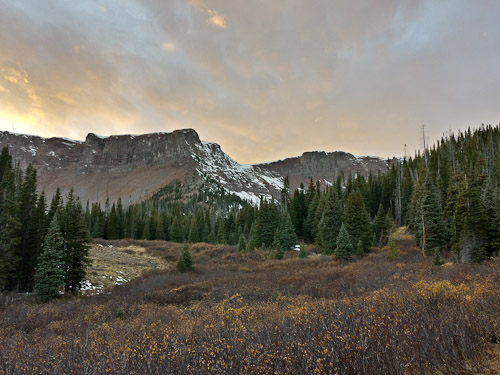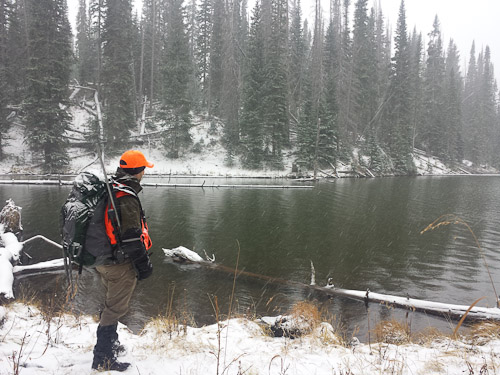Elk hunt
I’ll admit: when Tyler and I went elk hunting last year in western Colorado, we were a bit under-prepared. It’s probably a good thing that we didn’t harvest an elk then. Even the mule deer buck that we saw — but didn’t take, lacking a deer tag as we were — would have been a challenge to handle properly. This year was different.
This year, we had more firepower: two rifles instead of one. This year, we had a better season: “1st Rifle” instead of the much later and higher-trafficked “3rd Rifle”. This year, we had a better spot: near Yampa, Colorado in a game unit (GMU 231) with a history of excellent success rates.
Perhaps most important of all, this year we had more time. Whereas last year had been a quick overnight, this year we spent three days in the country.
That time began with a three hour drive from Denver, lunch at a small-town diner in Yampa that had friendly bad service, and a drive deep into the nearby Routt National Forest. Once we’d set up camp — just a tent, none of that RV nonsense — we set out for a late-afternoon hike.
Rifles in hand, orange on our heads and backs, we began trudging cross-country through the forest. The goal was to reach a series of clearings that had appeared on satellite images of the area, connect with a trail near the Flat Tops Wilderness boundary line, and continue pushing to higher elevations in the wilderness in search of bull elk. Very little snow had fallen that season, and daytime highs were still in the 60s, so we thought the elk were still likely to be up high.
We hiked, and the hours sped by. No elk.
Despite a lack of animals, there was an abundance of elk sign. Scat and tracks littered the ground, much of it appearing to be relatively new. We felt optimistic we were going to find a big bull every time we glassed a new clearing. That optimism continued right up until twilight and the end of legal hunting for the day, but the only woodland mammal we had seen was a porcupine. We began the multi-mile hike back down the mountain and out of the wilderness towards our camp. The increasing darkness was a bad time to discover that my headlamp batteries were nearly dead.

Flat Tops Wilderness at sunset, about 10500 ft in elevation and several miles into the hunt
Fortunately, Tyler’s headlamp was bright, so he led the way on the trail. As the first hour of the return journey bled into the second hour, I felt myself becoming increasingly drained. That was compounded once we exited the forest on a road and found ourselves still over a mile from our tent. The wind hadn’t been noticeable in the forest, but once on the road, the 30-50 mph gusts were strong enough to send my hat flying off of my head. Oh — and the road to camp was uphill the entire way.
By the time we made it back to camp, elkless and hours after nightfall, I was so exhausted that I didn’t even want to eat dinner. All I wanted to do was crawl into my sleeping bag and shut my eyes. Lucky for me that Tyler had the presense of mind and stamina to make burritos and tea. Hot food and drinks have an amazing way of reinvigorating the body, and I felt immensely better afterward.
It’s probably for the best that we didn’t take an elk that evening; it would have been a very late night, and stamina would have been an issue.
The winds shook the tent through the night, and their howling was punctuated by occasional sharp crashes as nearby trees and branches thundered to the ground. Sleep was minimal.
Yet, once 5:00 a.m. arrived, it was not particularly hard to get going. Yes, we were both sore, but we were also excited for the possibility of a successful hunt. Oatmeal and tea served as a quick breakfast, and then we drove my Outback down the road a ways to try a different spot. We were hiking in before sunrise.
After following a trail through the forest for a couple of miles, we found a multi-acre clearing on a grassy steep hill, so we left the trail to investigate. About 100 yards up the hill from the trail, we sat down on some rocks to glass the area; that location offered not only a view of most of the clearing but also of nearby ponds and more distant fields. Several quiet minutes went by before Tyler quietly yet excitedly whispered “Look!” and pointed to a mule deer. The young buck was about 150 yards away in the clearing and was moving uphill. He stopped for a moment, broadside to us, and then continued. Not long after that, several orange hats became visible in the woods; perhaps the buck had caught wind of those hunters and been pushed away from them.
We hunted some more in the immediate area before starting the hour-long hike back to the car for some lunch. All the way back, friendly sunshine was interspersed with angry dark clouds, but nothing save for a few flurries fell, and the temperature remained pleasantly cool. We took lunch in camp chairs by the car and packed up when the sun seemed unlikely to come back for the day.
Snow began to fall. Warmer jackets came out. We drove to the end of the road, Stillwater Reservoir, to start an afternoon hunt.
On the drive there, we had a brush with calamity. I was taking the washboarded dirt road a little — ahem — quickly, and an unexpectedly large bump suddenly jarred Sam. The TPMS light instantly lit up on the dashboard. A walk around the car showed no obvious problems except for the passenger-rear tire having a somewhat lower pressure than the others. I decided to check it again in a few minutes and drove on.
The snow was starting to accumulate by the time we made it to our trailhead. We decided to take only one rifle, my stainless steel Weatherby .308, since the other rifle, a 7mm Rem Mag, was not stainless and would thus be more vulnerable to rust. Thus equipped, we set off on the trail, which followed the reservoir for a short while before turning uphill into the wilderness.

Tyler looking across a lake during the hunt
It was a really nice hike, and it was easy to explore areas off of the trail, but we saw exactly zero animals of any sort. In hindsight, they were probably hunkered down out of the snow. Just before the Devil’s Causeway, we turned around. The snow was coming down in earnest by that point; our tracks from the hike up were quickly becoming nearly invisible.
Back at the car, Sam’s tire had lost a little more air, but not too much, so I felt comfortable driving back to camp.
It was a properly cold night. Inside the tent, it remained just above freezing, but it was probably in the mid-20s outside. In the morning, Tyler and I lazily let dawn arrive before mustering the courage to get out of our warm sleeping bags and greet the day. Around that time, we heard the sharp crack of a rifle shot. It would be the only one we would hear on the entire trip.
With the temperature low and having hunted the nearby terrain already, we struck camp and headed back into town for breakfast at the diner.
When we walked in, it was obvious we weren’t the only ones with that idea. Pretty much every head in the place was covered with a blaze orange hat. Service was again friendly-bad, and I’m not sure a big-city health inspector would have been thrilled with their methods, but it was a nice change of pace from camping.
On the way out, we struck up a conversation with an older hunter who seemed to have some experience with the area. It seems that we weren’t the only ones to get skunked. According to him, in previous years his friends had filled their tags on the first day in that unit, but something was different this year. He hadn’t seen anything, and while his friends had seen an elk or two, they had apparently missed shots on their only opportunities. I felt a bit better knowing that the problems weren’t unique to us.
Still would have been nice to get an elk though. Next year!
Recent Comments